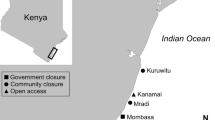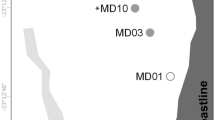Abstract
According to a widely accepted view of intertidal community organization in the north-west Atlantic Ocean, the abundance of perennial seaweeds is regulated by the activities of herbivores (which control ephemeral algal competitors) and carnivores (which control populations of competing filterfeeders). This concept was examined in 1987–1988 in a eulittoral belt on the Atlantic shores of Nova Scotia, Canada, dominated by a closed canopy of Fucus spiralis. A factorial design was used to test the effects of (a) grazers (there were no carnivores present, (b) adult F. spiralis canopy, and (c) substratum type on the abundance of perennial and ephemeral seaweeds. Grazers had no significant (p>0.05) effect on the density or cover of juvenile F. spiralis, but significantly reduced canopy cover of adults through the winter. The presence of grazers significantly enhanced the cover of ephemeral algae in early spring. Barnacle presence enhanced the cover of juvenile F. spiralis, but reduced the canopy of adult plants through abrasion. The most important regulator of recruitment density in F. spiralis was the presence of a canopy of conspecific adults. Canopy greatly reduced juvenile development. There was no significant relationship between the covers of perennial F. spiralis and ephemeral seaweeds. This study demonstrates that the recruitment of the perennial rockweed population examined is not dependent on the activities consumer animals. The results contrast with work in the midshore intertidal of New England, where the activities of herbivores are thought to regulate the abundances of perennial seaweeds.
Similar content being viewed by others
Literature cited
Branch, G. M. (1981). The biology of limpets: physical factors, energy flow and ecological interactions. Oceanogr. mar. Biol. A. Rev. 19: 235–280
Carpenter, R. (1986). Partitioning herbivory and its effects on coral reef algal communities. Ecol. Mongr. 56: 345–363
Grant, W. S. (1977). High intertidal community organization on a rocky headland in Maine, USA. Mar. Biol. 44: 15–25
Hawkins, S. J., Hartnoll, R. G. (1983). Grazing of intertidal algae by marine invertebrates. Oceanogr. mar. Biol. A. Rev. 21: 195–282
Littler, M. M., Littler, D. S. (1980). The evolution of thallus form and survival strategies in benthic marine algae: field and laboratory tests of a functional form model. Am. Nat. 116: 25–44
Lubchenco, J. (1980). Algal zonation in the New England rocky intertidal community: an experimental analysis. Ecology 61: 331–344
Lubchenco, J.: (1982). Effects of grazers and algal competitors on fucoid colonization in tide pools. J. Phycol. 18: 544–550
Lubchenco, J. (1983). Littorina and Fucus: effects of herbivores, substratum heterogeneity and plant escapes during succession. Ecology 64: 1116–1123
Lubchenco, J. (1986). Relative importance of competition and predation: early colonization by seaweeds in New England. In: Diamond, J., Case, T. J. (eds.) Community ecology. Harper & Row, New York, p. 537–555
Lubchenco, J., Menge, B. A. (1978). Community development and persistence in a low rocky intertidal zone. Ecol. Monogr. 48: 67–94
Menge, B. A. (1978). Predation intensity in a rocky intertidal community: relation between predator forging activity and environmental harshness. Oecologia 34: 1–16
Parker, T. (1987). The roles of gammarid amphipods and littorinid snails in high intertidal tide pools dominated by Fucus distichus. M. Sc. thesis, Dalhousie University, Halifax, N.S., Canada
Robertson, B. C. (1987). Reproductive ecology and canopy structure of Fucus spiralis L. Botanica mar. 30: 475–482
Stocker, L. (1986). Artifactual effects of caging on the recruitment and survivorship of a subtidal colonial invertebrate. Mar. Ecol. Prog. Ser. 34: 305–307
Author information
Authors and Affiliations
Additional information
Communicated by J. Mauchline, Oban
Rights and permissions
About this article
Cite this article
Chapman, A.R.O. Abundance of Fucus spiralis and ephemeral seaweeds in a high eulittoral zone: effects of grazers, canopy and substratum type. Mar. Biol. 102, 565–572 (1989). https://doi.org/10.1007/BF00438359
Accepted:
Issue Date:
DOI: https://doi.org/10.1007/BF00438359




